Published By:
Thunder Bay Press
Type:
Instructional Book with Supplies
MSRP:
$24.95
Other Building Toy Reviews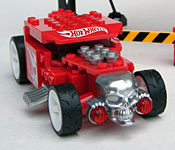
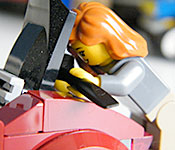
LaQ Frog
LEGO Fuel Tanker
K'NEX Greenhouse
Luke’s Toy Factory Fire Truck
LEGO 4-Wheelin’ Truck
K'NEX Ferris Wheel
Mega Bloks Super Stunt Test Facility
LEGO Fuel Pumper
Slotto Puzzle
LEGO Delivery Van
LEGO Batman: Riddler Chase
LEGO Flatbed Truck
LEGO Cement Mixer

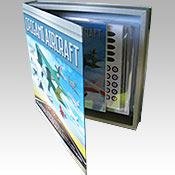
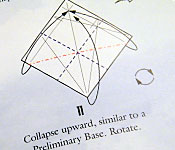
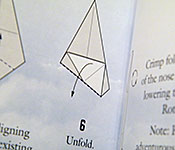
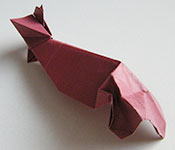
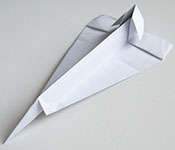
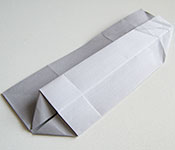
I first heard about this book/kit and its series at Toy Fair, and was immediately intrigued: creative, inexpensive, unique, and it recreated several of the most interesting and influential aircraft of the 20th century? Awesome! My review sample came, and I was further impressed by the main box. Nice, bold colors and sharp printing, hefty cardboard construction, and a magnetic clasp holding the cover closed over the beautifully displayed contents. These included a 112-page instruction/aviation history book, special preprinted origami paper, and five sticker sheets to detail the finished models. It was time to build some airplanes!
Strange thing, though...the big plastic blister holding the kit contents seemed to be stuck. "Probably just caught under the edge of one of the side walls," I thought, since these things can get bounced around quite a bit in shipping. Nope, it was glued to the back wall. Pulling it out left a tear on the back wall and an ugly smear of dried glue that whoever assembled it put down but had failed to contact the blister. Also, there seemed to be no way into the blister aside from cutting it. This was all very awkward, since the idea behind this box was clearly to provide people with a place to store all of their supplies between builds. Once I finally got to the contents, things were starting to look up: the paper looked and felt nice, the book had clear, bright pictures and seemed to have some good photos and writeups of the aircraft. Then I actually started reading it.
The first problem, near as I can tell, is that the book was assembled by someone trying to create an interesting narrative rather than an instruction manual. The introductory text seems to leave off mid-thought, only to be picked up several pages later with the text that gives us some history on the Sopwith Camel. The text is then broken by the instructions for the Camel, to be picked up on the Fokker Dr.1 page, and so on. It's an interesting idea, and if executed properly could have added some novelty to the standard instructional text, but here it just feels forced.
Worse, there was a clear effort to make the instructions fit the pages, rather than the other way around. This means that some instructions cram so many steps into a single panel that the illustration is nearly unreadable (top row, center), while other instructions were unnecessarily drawn out (top row, right). Adding to this, certain instructions tell you to go to a certain step in a different model and follow along there for a while before returning to your current build, making things that much more confusing.
With none of the models having any indication of their difficulty, I decided to try the Fokker Dr.1 after flipping through the book and seeing that it was both near the beginning and appeared to be rather short. I soon found out that the book was arranged chronologically rather than by difficulty, and the reason why it was so short was because partway through the build I needed to switch to the Sopwith Camel instructions for part of the fuselage and the wings. After an hour of trying to follow their steps and winding up with little more than a mushy wad of paper, I threw in the towel (bottom row, left).
I spent some more time reading through the manual to find something simpler. Everything with a propeller was out, since trying to fold that into shape is what finally lost me on the Dr.1. That left me with three options: a Boeing 707, a de Havilland Sea Vixen, or the Concorde. The 707 and Sea Vixen both used multiple sheets, so I went with the Concorde. One sheet, two pages, no problem.
Other than building it inside out, that is. Because of the way the instructions are drawn, there's some room for interpretation. Interpretation is bad when it comes to something like origami, as it is a precision art that requires exact standards. I did in fact get an airplane out of this one, so I can count it as a success, though it looks less like the Concorde and more like I got my paper airplane stuck in a fan (bottom row, center).
Conceding that I may simply be too "dumb" to build one of these—model building experience does not necessarily translate to origami skills—I asked my wife to take a crack at one. She was taught traditional origami when she was a kid, and to this day will turn napkin holders, receipts, etc. into miscellaneous fun things while killing time in restaurants. She noted that there were several nontraditional techniques used in the book, such as cutting and gluing the paper, but decided to try the Douglas DC-3.
Her DC-3 worked about as well as my Dr.1. Frustrated by the unclear and seemingly contradictory instructions, she quit partway through assembling the fuselage (bottom row, right).
Now at almost 1 for 3, I went a completely different route and Googled "origami aircraft instructions." That led me to Jayson Merrill's Origami Aircraft available as a PDF. The PDF was kind of gray, I was using notebook paper, and I flubbed the instructions near the end, but still ended up having more fun and building a more satisfying aircraft than I did with anything from Thunder Bay Press' book:
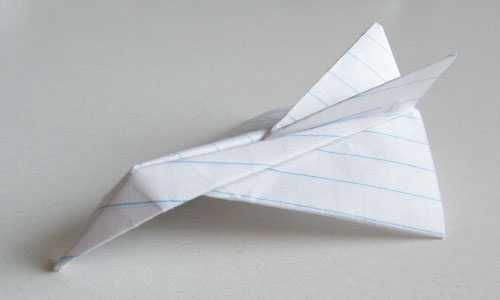
I was really hoping for more from this kit, but it's just not there. The packaging oddities can be overlooked, but the instructions are badly arranged and difficult to follow. It seems like too much effort was put into making things look nice rather than easy to use, and for something that is purely instructional that is a death sentence. Not even the supplemental material can save it...you can get a wider variety of similar paper in the scrapbook section of any craft store, and there is nothing in the way of historical information that can't be found at Wikipedia. Avoid this set.
or criticism about this review? Send us an e-mail!